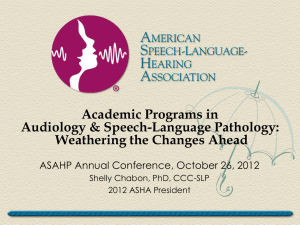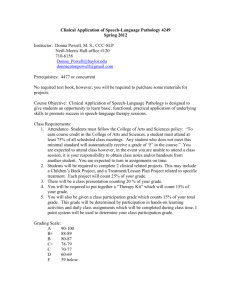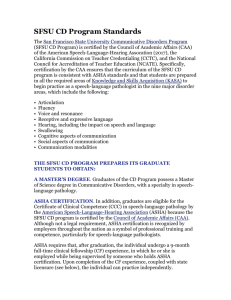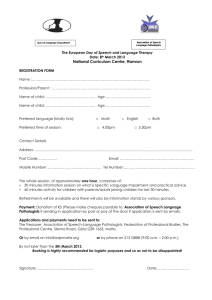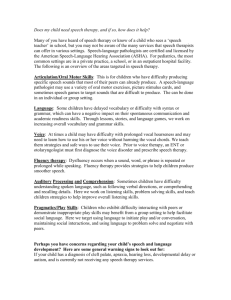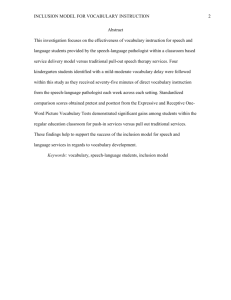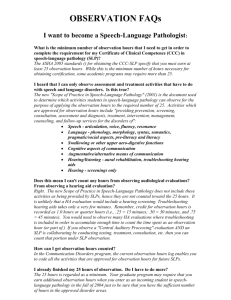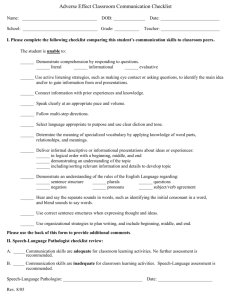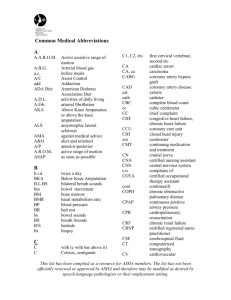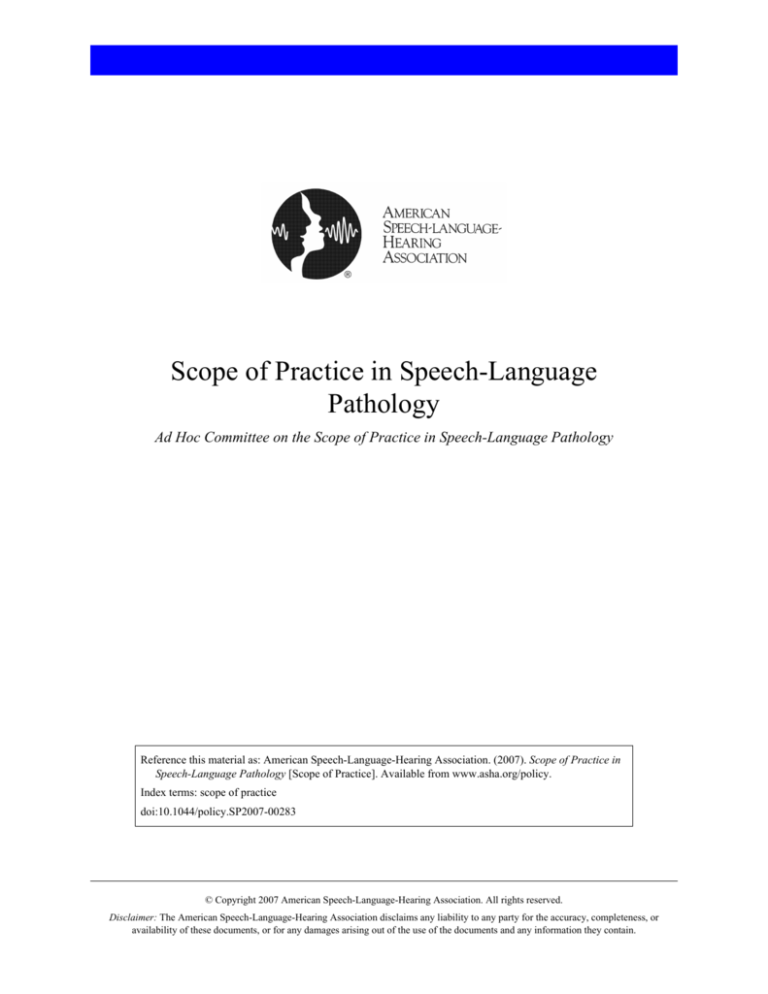
Scope of Practice in Speech-Language
Pathology
Ad Hoc Committee on the Scope of Practice in Speech-Language Pathology
Reference this material as: American Speech-Language-Hearing Association. (2007). Scope of Practice in
Speech-Language Pathology [Scope of Practice]. Available from www.asha.org/policy.
Index terms: scope of practice
doi:10.1044/policy.SP2007-00283
© Copyright 2007 American Speech-Language-Hearing Association. All rights reserved.
Disclaimer: The American Speech-Language-Hearing Association disclaims any liability to any party for the accuracy, completeness, or
availability of these documents, or for any damages arising out of the use of the documents and any information they contain.
Scope of Practice in Speech-Language Pathology
About This
Document
Scope of Practice
This scope of practice document is an official policy of the American SpeechLanguage-Hearing Association (ASHA) defining the breadth of practice within
the profession of speech-language pathology. This document was developed by
the ASHA Ad Hoc Committee on the Scope of Practice in Speech-Language
Pathology. Committee members were Kenn Apel (chair), Theresa E. Bartolotta,
Adam A. Brickell, Lynne E. Hewitt, Ann W. Kummer, Luis F. Riquelme, Jennifer
B. Watson, Carole Zangari, Brian B. Shulman (vice president for professional
practices in speech-language pathology), Lemmietta McNeilly (ex officio), and
Diane R. Paul (consultant). This document was approved by the ASHA Legislative
Council on September 4, 2007 (LC 09-07).
****
Introduction
The Scope of Practice in Speech-Language Pathology includes a statement of
purpose, a framework for research and clinical practice, qualifications of the
speech-language pathologist, professional roles and activities, and practice
settings. The speech-language pathologist is the professional who engages in
clinical services, prevention, advocacy, education, administration, and research in
the areas of communication and swallowing across the life span from infancy
through geriatrics. Given the diversity of the client population, ASHA policy
requires that these activities are conducted in a manner that takes into consideration
the impact of culture and linguistic exposure/acquisition and uses the best available
evidence for practice to ensure optimal outcomes for persons with communication
and/or swallowing disorders or differences.
As part of the review process for updating the Scope of Practice in SpeechLanguage Pathology, the committee made changes to the previous scope of
practice document that reflected recent advances in knowledge, understanding, and
research in the discipline. These changes included acknowledging roles and
responsibilities that were not mentioned in previous iterations of the Scope of
Practice (e.g., funding issues, marketing of services, focus on emergency
responsiveness, communication wellness). The revised document also was framed
squarely on two guiding principles: evidence-based practice and cultural and
linguistic diversity.
Statement of Purpose
The purpose of this document is to define the Scope of Practice in SpeechLanguage Pathology to
1. delineate areas of professional practice for speech-language pathologists;
2. inform others (e.g., health care providers, educators, other professionals,
consumers, payers, regulators, members of the general public) about
professional services offered by speech-language pathologists as qualified
providers;
3. support speech-language pathologists in the provision of high-quality,
evidence-based services to individuals with concerns about communication or
swallowing;
4. support speech-language pathologists in the conduct of research;
5. provide guidance for educational preparation and professional development of
speech-language pathologists.
1
Scope of Practice in Speech-Language Pathology
Scope of Practice
Figure 1. Conceptual Framework of ASHA Practice Documents
This document describes the breadth of professional practice offered within the
profession of speech-language pathology. Levels of education, experience, skill,
and proficiency with respect to the roles and activities identified within this scope
of practice document vary among individual providers. A speech-language
pathologist typically does not practice in all areas of the field. As the ASHA Code
of Ethics specifies, individuals may practice only in areas in which they are
competent (i.e., individuals' scope of competency), based on their education,
training, and experience.
In addition to this scope of practice document, other ASHA documents provide
more specific guidance for practice areas. Figure 1 illustrates the relationship
between the ASHA Code of Ethics, the Scope of Practice, and specific practice
documents. As shown, the ASHA Code of Ethics sets forth the fundamental
principles and rules considered essential to the preservation of the highest
standards of integrity and ethical conduct in the practice of speech-language
pathology.
Speech-language pathology is a dynamic and continuously developing profession.
As such, listing specific areas within this Scope of Practice does not exclude
emerging areas of practice. Further, speech-language pathologists may provide
additional professional services (e.g., interdisciplinary work in a health care
setting, collaborative service delivery in schools, transdisciplinary practice in early
intervention settings) that are necessary for the well-being of the individual(s) they
2
Scope of Practice in Speech-Language Pathology
Scope of Practice
are serving but are not addressed in this Scope of Practice. In such instances, it is
both ethically and legally incumbent upon professionals to determine whether they
have the knowledge and skills necessary to perform such services.
This scope of practice document does not supersede existing state licensure laws
or affect the interpretation or implementation of such laws. It may serve, however,
as a model for the development or modification of licensure laws.
Framework for
Research and
Clinical Practice
The overall objective of speech-language pathology services is to optimize
individuals' ability to communicate and swallow, thereby improving quality of life.
As the population profile of the United States continues to become increasingly
diverse (U.S. Census Bureau, 2005), speech-language pathologists have a
responsibility to be knowledgeable about the impact of these changes on clinical
services and research needs. Speech-language pathologists are committed to the
provision of culturally and linguistically appropriate services and to the
consideration of diversity in scientific investigations of human communication and
swallowing. For example, one aspect of providing culturally and linguistically
appropriate services is to determine whether communication difficulties
experienced by English language learners are the result of a communication
disorder in the native language or a consequence of learning a new language.
Additionally, an important characteristic of the practice of speech-language
pathology is that, to the extent possible, clinical decisions are based on best
available evidence. ASHA has defined evidence-based practice in speechlanguage pathology as an approach in which current, high-quality research
evidence is integrated with practitioner expertise and the individual's preferences
and values into the process of clinical decision making (ASHA, 2005). A highquality basic, applied, and efficacy research base in communication sciences and
disorders and related fields of study is essential to providing evidence-based
clinical practice and quality clinical services. The research base can be enhanced
by increased interaction and communication with researchers across the United
States and from other countries. As our global society is becoming more connected,
integrated, and interdependent, speech-language pathologists have access to an
abundant array of resources, information technology, and diverse perspectives and
influence (e.g., Lombardo, 1997). Increased national and international interchange
of professional knowledge, information, and education in communication sciences
and disorders can be a means to strengthen research collaboration and improve
clinical services.
The World Health Organization (WHO) has developed a multipurpose health
classification system known as the International Classification of Functioning,
Disability and Health (ICF; WHO, 2001). The purpose of this classification system
is to provide a standard language and framework for the description of functioning
and health. The ICF framework is useful in describing the breadth of the role of
3
Scope of Practice in Speech-Language Pathology
Scope of Practice
the speech-language pathologist in the prevention, assessment, and habilitation/
rehabilitation, enhancement, and scientific investigation of communication and
swallowing. It consists of two components:
• Health Conditions
º Body Functions and Structures: These involve the anatomy and physiology
of the human body. Relevant examples in speech-language pathology
include craniofacial anomaly, vocal fold paralysis, cerebral palsy,
stuttering, and language impairment.
º Activity and Participation: Activity refers to the execution of a task or
action. Participation is the involvement in a life situation. Relevant
examples in speech-language pathology include difficulties with
swallowing safely for independent feeding, participating actively in class,
understanding a medical prescription, and accessing the general education
curriculum.
• Contextual Factors
º Environmental Factors: These make up the physical, social, and attitudinal
environments in which people live and conduct their lives. Relevant
examples in speech-language pathology include the role of the
communication partner in augmentative and alternative communication,
the influence of classroom acoustics on communication, and the impact of
institutional dining environments on individuals' ability to safely maintain
nutrition and hydration.
º Personal Factors: These are the internal influences on an individual's
functioning and disability and are not part of the health condition. These
factors may include, but are not limited to, age, gender, ethnicity,
educational level, social background, and profession. Relevant examples
in speech-language pathology might include a person's background or
culture that influences his or her reaction to a communication or
swallowing disorder.
The framework in speech-language pathology encompasses these health
conditions and contextual factors. The health condition component of the ICF can
be expressed on a continuum of functioning. On one end of the continuum is intact
functioning. At the opposite end of the continuum is completely compromised
functioning. The contextual factors interact with each other and with the health
conditions and may serve as facilitators or barriers to functioning. Speechlanguage pathologists may influence contextual factors through education and
advocacy efforts at local, state, and national levels. Relevant examples in speechlanguage pathology include a user of an augmentative communication device
needing classroom support services for academic success, or the effects of
premorbid literacy level on rehabilitation in an adult post brain injury. Speechlanguage pathologists work to improve quality of life by reducing impairments of
body functions and structures, activity limitations, participation restrictions, and
barriers created by contextual factors.
Qualifications
Speech-language pathologists, as defined by ASHA, hold the ASHA Certificate
of Clinical Competence in Speech-Language Pathology (CCC-SLP), which
requires a master's, doctoral, or other recognized postbaccalaureate degree. ASHAcertified speech-language pathologists complete a supervised postgraduate
professional experience and pass a national examination as described in the ASHA
certification standards. Demonstration of continued professional development is
4
Scope of Practice in Speech-Language Pathology
Scope of Practice
mandated for the maintenance of the CCC-SLP. Where applicable, speechlanguage pathologists hold other required credentials (e.g., state licensure, teaching
certification).
This document defines the scope of practice for the field of speech-language
pathology. Each practitioner must evaluate his or her own experiences with
preservice education, clinical practice, mentorship and supervision, and continuing
professional development. As a whole, these experiences define the scope of
competence for each individual. Speech-language pathologists may engage in only
those aspects of the profession that are within their scope of competence.
As primary care providers for communication and swallowing disorders, speechlanguage pathologists are autonomous professionals; that is, their services are not
prescribed or supervised by another professional. However, individuals frequently
benefit from services that include speech-language pathologist collaborations with
other professionals.
Professional Roles
and Activities
Speech-language pathologists serve individuals, families, and groups from diverse
linguistic and cultural backgrounds. Services are provided based on applying the
best available research evidence, using expert clinical judgments, and considering
clients' individual preferences and values. Speech-language pathologists address
typical and atypical communication and swallowing in the following areas:
• speech sound production
º articulation
º apraxia of speech
º dysarthria
º ataxia
º dyskinesia
• resonance
º hypernasality
º hyponasality
º cul-de-sac resonance
º mixed resonance
• voice
º phonation quality
º pitch
º loudness
º respiration
• fluency
º stuttering
º cluttering
• language (comprehension and expression)
º phonology
º morphology
º syntax
º semantics
º pragmatics (language use, social aspects of communication)
º literacy (reading, writing, spelling)
º prelinguistic communication (e.g., joint attention, intentionality,
communicative signaling)
º paralinguistic communication
5
Scope of Practice in Speech-Language Pathology
Scope of Practice
• cognition
º attention
º memory
º sequencing
º problem solving
º executive functioning
• feeding and swallowing
º oral, pharyngeal, laryngeal, esophageal
º orofacial myology (including tongue thrust)
º oral-motor functions
Potential etiologies of communication and swallowing disorders include
• neonatal problems (e.g., prematurity, low birth weight, substance exposure);
• developmental disabilities (e.g., specific language impairment, autism
spectrum disorder, dyslexia, learning disabilities, attention deficit disorder);
• auditory problems (e.g., hearing loss or deafness);
• oral anomalies (e.g., cleft lip/palate, dental malocclusion, macroglossia, oralmotor dysfunction);
• respiratory compromise (e.g., bronchopulmonary dysplasia, chronic
obstructive pulmonary disease);
• pharyngeal anomalies (e.g., upper airway obstruction, velopharyngeal
insufficiency/incompetence);
• laryngeal anomalies (e.g., vocal fold pathology, tracheal stenosis,
tracheostomy);
• neurological disease/dysfunction (e.g., traumatic brain injury, cerebral palsy,
cerebral vascular accident, dementia, Parkinson's disease, amyotrophic lateral
sclerosis);
• psychiatric disorder (e.g., psychosis, schizophrenia);
• genetic disorders (e.g., Down syndrome, fragile X syndrome, Rett syndrome,
velocardiofacial syndrome).
The professional roles and activities in speech-language pathology include clinical/
educational services (diagnosis, assessment, planning, and treatment), prevention
and advocacy, and education, administration, and research.
Clinical Services
Speech-language pathologists provide clinical services that include the following:
• prevention and pre-referral
• screening
• assessment/evaluation
• consultation
• diagnosis
• treatment, intervention, management
• counseling
• collaboration
• documentation
• referral
Examples of these clinical services include
1. using data to guide clinical decision making and determine the effectiveness
of services;
6
Scope of Practice in Speech-Language Pathology
Scope of Practice
2. making service delivery decisions (e.g., admission/eligibility, frequency,
duration, location, discharge/dismissal) across the lifespan;
3. determining appropriate context(s) for service delivery (e.g., home, school,
telepractice, community);
4. documenting provision of services in accordance with accepted procedures
appropriate for the practice setting;
5. collaborating with other professionals (e.g., identifying neonates and infants
at risk for hearing loss, participating in palliative care teams, planning lessons
with educators, serving on student assistance teams);
6. screening individuals for hearing loss or middle ear pathology using
conventional pure-tone air conduction methods (including otoscopic
inspection), otoacoustic emissions screening, and/or screening tympanometry;
7. providing intervention and support services for children and adults diagnosed
with speech and language disorders;
8. providing intervention and support services for children and adults diagnosed
with auditory processing disorders;
9. using instrumentation (e.g., videofluoroscopy, electromyography,
nasendoscopy, stroboscopy, endoscopy, nasometry, computer technology) to
observe, collect data, and measure parameters of communication and
swallowing or other upper aerodigestive functions;
10. counseling individuals, families, coworkers, educators, and other persons in
the community regarding acceptance, adaptation, and decision making about
communication and swallowing;
11. facilitating the process of obtaining funding for equipment and services related
to difficulties with communication and swallowing;
12. serving as case managers, service delivery coordinators, and members of
collaborative teams (e.g., individualized family service plan and
individualized education program teams, transition planning teams);
13. providing referrals and information to other professionals, agencies, and/or
consumer organizations;
14. developing, selecting, and prescribing multimodal augmentative and
alternative communication systems, including unaided strategies (e.g., manual
signs, gestures) and aided strategies (e.g., speech-generating devices, manual
communication boards, picture schedules);
15. providing services to individuals with hearing loss and their families/
caregivers (e.g., auditory training for children with cochlear implants and
hearing aids; speechreading; speech and language intervention secondary to
hearing loss; visual inspection and listening checks of amplification devices
for the purpose of troubleshooting, including verification of appropriate
battery voltage);
16. addressing behaviors (e.g., perseverative or disruptive actions) and
environments (e.g., classroom seating, positioning for swallowing safety or
attention, communication opportunities) that affect communication and
swallowing;
17. selecting, fitting, and establishing effective use of prosthetic/adaptive devices
for communication and swallowing (e.g., tracheoesophageal prostheses,
speaking valves, electrolarynges; this service does not include the selection or
fitting of sensory devices used by individuals with hearing loss or other
auditory perceptual deficits, which falls within the scope of practice of
audiologists; ASHA, 2004);
7
Scope of Practice in Speech-Language Pathology
Scope of Practice
18. providing services to modify or enhance communication performance (e.g.,
accent modification, transgender voice, care and improvement of the
professional voice, personal/professional communication effectiveness).
Prevention and
Advocacy
Speech-language pathologists engage in prevention and advocacy activities related
to human communication and swallowing. Example activities include
1. improving communication wellness by promoting healthy lifestyle practices
that can help prevent communication and swallowing disorders (e.g., cessation
of smoking, wearing helmets when bike riding);
2. presenting primary prevention information to individuals and groups known
to be at risk for communication disorders and other appropriate groups;
3. providing early identification and early intervention services for
communication disorders;
4. advocating for individuals and families through community awareness, health
literacy, education, and training programs to promote and facilitate access to
full participation in communication, including the elimination of societal,
cultural, and linguistic barriers;
5. advising regulatory and legislative agencies on emergency responsiveness to
individuals who have communication and swallowing disorders or difficulties;
6. promoting and marketing professional services;
7. advocating at the local, state, and national levels for improved administrative
and governmental policies affecting access to services for communication and
swallowing;
8. advocating at the local, state, and national levels for funding for research;
9. recruiting potential speech-language pathologists into the profession;
10. participating actively in professional organizations to contribute to best
practices in the profession.
Education,
Administration, and
Research
Speech-language pathologists also serve as educators, administrators, and
researchers. Example activities for these roles include
1. educating the public regarding communication and swallowing;
2. educating and providing in-service training to families, caregivers, and other
professionals;
3. educating, supervising, and mentoring current and future speech-language
pathologists;
4. educating, supervising, and managing speech-language pathology assistants
and other support personnel;
5. fostering public awareness of communication and swallowing disorders and
their treatment;
6. serving as expert witnesses;
7. administering and managing clinical and academic programs;
8. developing policies, operational procedures, and professional standards;
9. conducting basic and applied/translational research related to communication
sciences and disorders, and swallowing.
Practice Settings
Speech-language pathologists provide services in a wide variety of settings, which
may include but are not exclusive to
1. public and private schools;
8
Scope of Practice in Speech-Language Pathology
Scope of Practice
2. early intervention settings, preschools, and day care centers;
3. health care settings (e.g., hospitals, medical rehabilitation facilities, long-term
care facilities, home health agencies, clinics, neonatal intensive care units,
behavioral/mental health facilities);
4. private practice settings;
5. universities and university clinics;
6. individuals' homes and community residences;
7. supported and competitive employment settings;
8. community, state, and federal agencies and institutions;
9. correctional institutions;
10. research facilities;
11. corporate and industrial settings.
References
Resources
American Speech-Language-Hearing Association. (2004). Scope of practice in audiology.
Available from www.asha.org/policy.
American Speech-Language-Hearing Association. (2005). Evidence-based practice in
communication disorders [Position statement]. Available from www.asha.org/policy.
Lombardo, T. (1997, Spring). The impact of information technology: Learning, living, and
loving in the future. The Labyrinth: Sharing Information on Learning Technologies. 5
(2). Available from www.mcli.dist.maricopa.edu/LF/Spr97/spr97L8.html.
U.S. Census Bureau. (2005). Population profile of the United States: Dynamic version. Race
and Hispanic origin in 2005. Available from www.census.gov.
World Health Organization. (2001). International classification of functioning, disability
and health. Geneva, Switzerland: Author.
ASHA Cardinal Documents
American Speech-Language-Hearing Association. (2003). Code of ethics (Revised).
Available from www.asha.org/policy.
American Speech-Language-Hearing Association. (2004). Preferred practice patterns for
the profession of speech-language pathology. Available from www.asha.org/policy.
American Speech-Language-Hearing Association. (2005). Standards for the certificate of
clinical competence in speech-language pathology. Available from www.asha.org/
about/membership-certification/handbooks/slp/slp_standards.htm.
General Service Delivery Issues
Admission/Discharge Criteria
American Speech-Language-Hearing Association. (2004). Admission/discharge criteria in
speech-language pathology [Guidelines]. Available from www.asha.org/policy.
Autonomy
American Speech-Language-Hearing Association. (1986). Autonomy of speech-language
pathology and audiology [Relevant paper]. Available from www.asha.org/policy.
Culturally and Linguistically Appropriate Services
American Speech-Language-Hearing Association. (2002). American English dialects
[Technical report]. Available from www.asha.org/policy.
American Speech-Language-Hearing Association. (2004). Knowledge and skills needed by
speech-language pathologists and audiologists to provide culturally and linguistically
appropriate services [Knowledge and skills]. Available from www.asha.org/policy.
Definitions and Terminology
American Speech-Language-Hearing Association. (1982). Language [Relevant paper].
Available from www.asha.org/policy.
9
Scope of Practice in Speech-Language Pathology
Scope of Practice
American Speech-Language-Hearing Association. (1986). Private practice [Definition].
Available from www.asha.org/policy.
American Speech-Language-Hearing Association. (1993). Definition of communication
disorders and variations [Definition]. Available from www.asha.org/policy.
American Speech-Language-Hearing Association. (1998). Terminology pertaining to
fluency and fluency disorders [Guidelines]. Available from www.asha.org/policy.
Evidence-Based Practice
American Speech-Language-Hearing Association. (2004). Evidence-based practice in
communication disorders: An introduction [Technical report]. Available from
www.asha.org/policy.
American Speech-Language-Hearing Association. (2005). Evidence-based practice in
communication disorders: An introduction [Position statement]. Available from
www.asha.org/policy.
Private Practice
American Speech-Language-Hearing Association. (1990). Considerations for establishing
a private practice in audiology and/or speech-language pathology [Technical report].
Available from www.asha.org/policy.
American Speech-Language-Hearing Association. (1991). Private practice [Technical
report]. Available from www.asha.org/policy.
American Speech-Language-Hearing Association. (1994). Professional liability and risk
management for the audiology and speech-language pathology professions [Technical
report]. Available from www.asha.org/policy.
American Speech-Language-Hearing Association. (2002). Drawing cases for private
practice from primary place of employment [Issues in ethics]. Available from
www.asha.org/policy.
Professional Service Programs
American Speech-Language-Hearing Association. (2005). Quality indicators for
professional service programs in audiology and speech-language pathology [Quality
indicators]. Available from www.asha.org/policy.
Speech-Language Pathology Assistants
American Speech-Language-Hearing Association. (2001). Knowledge and skills for
supervisors of speech-language pathology assistants [Knowledge and skills]. Available
from www.asha.org/policy.
American Speech-Language-Hearing Association. (2004). Guidelines for the training, use,
and supervision of speech-language pathology assistants [Guidelines]. Available from
www.asha.org/policy.
American Speech-Language-Hearing Association. (2004). Support personnel [Issues in
ethics]. Available from www.asha.org/policy.
American Speech-Language-Hearing Association. (2004). Training, use, and supervision
of support personnel in speech-language pathology [Position statement]. Available from
www.asha.org/policy.
Supervision
American Speech-Language-Hearing Association. (1985). Clinical supervision in speechlanguage pathology and audiology [Position statement]. Available from www.asha.org/
policy.
American Speech-Language-Hearing Association. (2004). Clinical fellowship supervisor's
responsibilities [Issues in ethics]. Available from www.asha.org/policy.
American Speech-Language-Hearing Association. (2004). Supervision of student
clinicians [Issues in ethics]. Available from www.asha.org/policy.
10
Scope of Practice in Speech-Language Pathology
Scope of Practice
Clinical Services and Populations
Apraxia of Speech
American Speech-Language-Hearing Association. (2007). Childhood apraxia of speech
[Position statement]. Available from www.asha.org/policy.
American Speech-Language-Hearing Association. (2007). Childhood apraxia of speech
[Technical report]. Available from www.asha.org/policy.
Auditory Processing
American Speech-Language-Hearing Association. (1995). Central auditory processing:
Current status of research and implications for clinical practice [Technical report].
Available from www.asha.org/policy.
American Speech-Language-Hearing Association. (2005). (Central) auditory processing
disorders [Technical report]. Available from www.asha.org/policy.
American Speech-Language-Hearing Association. (2005). (Central) auditory processing
disorders—the role of the audiologist [Position statement]. Available from
www.asha.org/policy.
Augmentative and Alternative Communication (AAC)
American Speech-Language-Hearing Association. (1998). Maximizing the provision of
appropriate technology services and devices for students in schools [Technical report].
Available from www.asha.org/policy.
American Speech-Language-Hearing Association. (2001). Augmentative and alternative
communication: Knowledge and skills for service delivery [Knowledge and skills].
Available from www.asha.org/policy.
American Speech-Language-Hearing Association. (2004). Roles and responsibilities of
speech-language pathologists with respect to augmentative and alternative
communication [Position statement]. Available from www.asha.org/policy.
American Speech-Language-Hearing Association. (2004). Roles and responsibilities of
speech-language pathologists with respect to augmentative and alternative
communication [Technical report]. Available from www.asha.org/policy.
Aural Rehabilitation
American Speech-Language-Hearing Association. (2001). Knowledge and skills required
for the practice of audiologic/aural rehabilitation [Knowledge and skills]. Available
from www.asha.org/policy.
Autism Spectrum Disorders
American Speech-Language-Hearing Association. (2006). Guidelines for speech-language
pathologists in diagnosis, assessment, and treatment of autism spectrum disorders
across the life span [Guidelines]. Available from www.asha.org/policy.
American Speech-Language-Hearing Association. (2006). Knowledge and skills needed by
speech-language pathologists for diagnosis, assessment, and treatment of autism
spectrum disorders across the life span [Knowledge and skills]. Available from
www.asha.org/policy.
American Speech-Language-Hearing Association. (2006). Principles for speech-language
pathologists in diagnosis, assessment, and treatment of autism spectrum disorders
across the life span [Technical report]. Available from www.asha.org/policy.
American Speech-Language-Hearing Association. (2006). Roles and responsibilities of
speech-language pathologists in diagnosis, assessment, and treatment of autism
spectrum disorders across the life span [Position statement]. Available from
www.asha.org/policy.
11
Scope of Practice in Speech-Language Pathology
Scope of Practice
Filipek, P. A., Accardo, P. J., Ashwal, S., Baranek, G. T., Cook, E. H., Dawson, G., et al.
(2000). Practice parameter: Screening and diagnosis of autism—report of the Quality
Standards Subcommittee of the American Academy of Neurology and the Child
Neurology Society Neurology, 55, 468–479
Cognitive Aspects of Communication
American Speech-Language-Hearing Association. (1990). Interdisciplinary approaches to
brain damage [Position statement]. Available from www.asha.org/policy.
American Speech-Language-Hearing Association. (1995). Guidelines for the structure and
function of an interdisciplinary team for persons with brain injury [Guidelines].
Available from www.asha.org/policy.
American Speech-Language-Hearing Association. (2003). Evaluating and treating
communication and cognitive disorders: Approaches to referral and collaboration for
speech-language pathology and clinical neuropsychology [Technical report]. Available
from www.asha.org/policy.
American Speech-Language-Hearing Association. (2003). Rehabilitation of children and
adults with cognitive-communication disorders after brain injury [Technical report].
Available from www.asha.org/policy.
American Speech-Language-Hearing Association. (2005). Knowledge and skills needed by
speech-language pathologists providing services to individuals with cognitivecommunication disorders [Knowledge and skills]. Available from www.asha.org/
policy.
American Speech-Language-Hearing Association. (2005). Roles of speech-language
pathologists in the identification, diagnosis, and treatment of individuals with cognitivecommunication disorders: Position statement. Available from www.asha.org/policy.
Deaf and Hard of Hearing
American Speech-Language-Hearing Association. (2004). Roles of speech-language
pathologists and teachers of children who are deaf and hard of hearing in the
development of communicative and linguistic competence [Guidelines]. Available from
www.asha.org/policy.
American Speech-Language-Hearing Association. (2004). Roles of speech-language
pathologists and teachers of children who are deaf and hard of hearing in the
development of communicative and linguistic competence [Position statement].
Available from www.asha.org/policy.
American Speech-Language-Hearing Association. (2004). Roles of speech-language
pathologists and teachers of children who are deaf and hard of hearing in the
development of communicative and linguistic competence [Technical report]. Available
from www.asha.org/policy.
Dementia
American Speech-Language-Hearing Association. (2005). The roles of speech-language
pathologists working with dementia-based communication disorders [Position
statement]. Available from www.asha.org/policy.
American Speech-Language-Hearing Association. (2005). The roles of speech-language
pathologists working with dementia-based communication disorders [Technical report].
Available from www.asha.org/policy.
Early Intervention
American Speech-Language-Hearing Association. Roles and responsibilities of speechlanguage pathologists in early intervention (in preparation). [Position statement,
Technical report, Guidelines, and Knowledge and skills].
12
Scope of Practice in Speech-Language Pathology
Scope of Practice
National Joint Committee on Learning Disabilities (2006). Learning disabilities and young
children: Identification and intervention Available from www.ldonline.org/article/
11511?theme=print.
Fluency
American Speech-Language-Hearing Association. (1995). Guidelines for practice in
stuttering treatment [Guidelines]. Available from www.asha.org/policy.
Hearing Screening
American Speech-Language-Hearing Association. (1997). Guidelines for audiologic
screening [Guidelines]. Available from www.asha.org/policy.
American Speech-Language-Hearing Association. (2004). Clinical practice by certificate
holders in the profession in which they are not certified [Issues in ethics]. Available from
www.asha.org/policy.
Language and Literacy
American Speech-Language-Hearing Association. (1981). Language learning disorders
[Position statement]. Available from www.asha.org/policy.
American Speech-Language-Hearing Association and the National Association of School
Psychologists (1987). Identification of children and youths with language learning
disorders [Position statement]. Available from www.asha.org/policy.
American Speech-Language-Hearing Association. (2000). Roles and responsibilities of
speech-language pathologists with respect to reading and writing in children and
adolescents [Guidelines]. Available from www.asha.org/policy.
American Speech-Language-Hearing Association. (2000). Roles and responsibilities of
speech-language pathologists with respect to reading and writing in children and
adolescents [Position statement]. Available from www.asha.org/policy.
American Speech-Language-Hearing Association. (2000). Roles and responsibilities of
speech-language pathologists with respect to reading and writing in children and
adolescents [Technical report]. Available from www.asha.org/policy.
American Speech-Language-Hearing Association. (2002). Knowledge and skills needed by
speech-language pathologists with respect to reading and writing in children and
adolescents [Knowledge and skills]. Available from www.asha.org/policy.
Mental Retardation/Developmental Disabilities
American Speech-Language-Hearing Association. (2005). Knowledge and skills needed by
speech-language pathologists serving persons with mental retardation/developmental
disabilities [Knowledge and skills]. Available from www.asha.org/policy.
American Speech-Language-Hearing Association. (2005). Principles for speech-language
pathologists serving persons with mental retardation/developmental disabilities
[Technical report]. Available from www.asha.org/policy.
American Speech-Language-Hearing Association. (2005). Roles and responsibilities of
speech-language pathologists serving persons withmental retardation/developmental
disabilities [Guidelines]. Available from www.asha.org/policy.
American Speech-Language-Hearing Association. (2005). Roles and responsibilities of
speech-language pathologists serving persons withmental retardation/developmental
disabilities [Position statement]. Available from www.asha.org/policy.
Orofacial Myofunctional Disorders
American Speech-Language-Hearing Association. (1989). Labial-lingual posturing
function [Technical report]. Available from www.asha.org/policy.
American Speech-Language-Hearing Association. (1991). The role of the speech-language
pathologist in assessment and management of oral myofunctional disorders [Position
statement]. Available from www.asha.org/policy.
13
Scope of Practice in Speech-Language Pathology
Scope of Practice
American Speech-Language-Hearing Association. (1993). Orofacial myofunctional
disorders [Knowledge and skills]. Available from www.asha.org/policy.
Prevention
American Speech-Language-Hearing Association. (1987). Prevention of communication
disorders [Position statement]. Available from www.asha.org/policy.
American Speech-Language-Hearing Association. (1987). Prevention of communication
disorders tutorial [Relevant paper]. Available from www.asha.org/policy.
Severe Disabilities
National Joint Committee for the Communication Needs of Persons With Severe
Disabilities. (1991). Guidelines for meeting the communication needs of persons with
severe disabilities. Available from www.asha.org/docs/html/GL1992-00201.html.
National Joint Committee for the Communication Needs of Persons With Severe
Disabilities (2002). Access to communication services and supports: Concerns
regarding the application of restrictive “eligibility” policies [Technical report].
Available from www.asha.org/policy.
National Joint Committee for the Communication Needs of Persons With Severe
Disabilities (2003). Access to communication services and supports: Concerns
regarding the application of restrictive “eligibility” policies [Position statement].
Available from www.asha.org/policy.
Social Aspects of Communication
American Speech-Language-Hearing Association. (1991). Guidelines for speech-language
pathologists serving persons with language, socio-communicative and/or cognitivecommunicative impairments [Guidelines]. Available from www.asha.org/policy.
Swallowing
American Speech-Language-Hearing Association. (1992). Instrumental diagnostic
procedures for swallowing [Guidelines]. Available from www.asha.org/policy.
American Speech-Language-Hearing Association. (1992). Instrumental diagnostic
procedures for swallowing [Position statement]. Available from www.asha.org/policy.
American Speech-Language-Hearing Association. (2000). Clinical indicators for
instrumental assessment of dysphagia [Guidelines]. Available from www.asha.org/
policy.
American Speech-Language-Hearing Association. (2001). Knowledge and skills needed by
speech-language pathologists providing services to individuals with swallowing and/or
feeding disorders [Knowledge and skills]. Available from www.asha.org/policy.
American Speech-Language-Hearing Association. (2001). Knowledge and skills for
speech-language pathologists performing endoscopic assessment of swallowing
functions [Knowledge and skills]. Available from www.asha.org/policy.
American Speech-Language-Hearing Association. (2001). Roles of speech-language
pathologists in swallowing and feeding disorders [Position statement]. Available from
www.asha.org/policy.
American Speech-Language-Hearing Association. (2001). Roles of speech-language
pathologists in swallowing and feeding disorders [Technical report]. Available from
www.asha.org/policy.
American Speech-Language-Hearing Association. (2004). Guidelines for speech-language
pathologists performing videofluoroscopic swallowing studies. [Guidelines]. Available
from www.asha.org/policy.
American Speech-Language-Hearing Association. (2004). Knowledge and skills needed by
speech-language pathologists performing videofluoroscopic swallowing studies
Available from www.asha.org/policy.
14
Scope of Practice in Speech-Language Pathology
Scope of Practice
American Speech-Language-Hearing Association. (2004). Role of the speech-language
pathologist in the performance and interpretation of endoscopic evaluation of
swallowing [Guidelines]. Available from www.asha.org/policy.
American Speech-Language-Hearing Association. (2004). Role of the speech-language
pathologist in the performance and interpretation of endoscopic evaluation of
swallowing [Position statement]. Available from www.asha.org/policy.
American Speech-Language-Hearing Association. (2004). Role of the speech-language
pathologist in the performance and interpretation of endoscopic evaluation of
swallowing [Technical report]. Available from www.asha.org/policy.
American Speech-Language-Hearing Association. (2004). Speech-language pathologists
training and supervising other professionals in the delivery of services to individuals
with swallowing and feeding disorders [Technical report]. Available from
www.asha.org/policy.
Voice and Resonance
American Speech-Language-Hearing Association. (1993). Oral and oropharyngeal
prostheses [Guidelines]. Available from www.asha.org/policy.
American Speech-Language-Hearing Association. (1993). Oral and oropharyngeal
prostheses [Position statement]. Available from www.asha.org/policy.
American Speech-Language-Hearing Association. (1993). Use of voice prostheses in
tracheotomized persons with or without ventilatory dependence [Guidelines]. Available
from www.asha.org/policy.
American Speech-Language-Hearing Association. (1993). Use of voice prostheses in
tracheotomized persons with or without ventilatory dependence [Position statement].
Available from www.asha.org/policy.
American Speech-Language-Hearing Association. (1998). The roles of otolaryngologists
and speech-language pathologists in the performance and interpretation of
strobovideolaryngoscopy [Relevant paper]. Available from www.asha.org/policy.
American Speech-Language-Hearing Association. (2004). Evaluation and treatment for
tracheoesophageal puncture and prosthesis [Technical report]. Available from
www.asha.org/policy.
American Speech-Language-Hearing Association. (2004). Knowledge and skills for
speech-language pathologists with respect to evaluation and treatment for
tracheoesophageal puncture and prosthesis [Knowledge and skills]. Available from
www.asha.org/policy.
American Speech-Language-Hearing Association. (2004). Roles and responsibilities of
speech-language pathologists with respect to evaluation and treatment for
tracheoesophageal puncture and prosthesis [Position statement]. Available from
www.asha.org/policy.
American Speech-Language-Hearing Association. (2004). Vocal tract visualization and
imaging [Position statement]. Available from www.asha.org/policy.
American Speech-Language-Hearing Association. (2004). Vocal tract visualization and
imaging [Technical report]. Available from www.asha.org/policy.
American Speech-Language-Hearing Association. (2005). The role of the speech-language
pathologist, the teacher of singing, and the speaking voice trainer in voice habilitation
[Technical report]. Available from www.asha.org/policy.
American Speech-Language-Hearing Association. (2005). The use of voice therapy in the
treatment of dysphonia [Technical report]. Available from www.asha.org/policy.
Health Care Services
Business Practices in Health Care Settings
American Speech-Language-Hearing Association. (2002). Knowledge and skills in business
practices needed by speech-language pathologists in health care settings [Knowledge
and skills]. Available from www.asha.org/policy.
15
Scope of Practice in Speech-Language Pathology
Scope of Practice
American Speech-Language-Hearing Association. (2004). Knowledge and skills in business
practices for speech-language pathologists who are managers and leaders in health
care organizations [Knowledge and skills]. Available from www.asha.org/policy.
Multiskilling
American Speech-Language-Hearing Association. (1996). Multiskilled personnel [Position
statement]. Available from www.asha.org/policy.
American Speech-Language-Hearing Association. (1996). Multiskilled personnel
[Technical report]. Available from www.asha.org/policy.
Neonatal Intensive Care Unit
American Speech-Language-Hearing Association. (2004). Knowledge and skills needed by
speech-language pathologists providing services to infants and families in the NICU
environment [Knowledge and skills]. Available from www.asha.org/policy.
American Speech-Language-Hearing Association. (2004). Roles and responsibilities of
speech-language pathologists in the neonatal intensive care unit [Guidelines]. Available
from www.asha.org/policy.
American Speech-Language-Hearing Association. (2004). Roles and responsibilities of
speech-language pathologists in the neonatal intensive care unit [Position statement].
Available from www.asha.org/policy.
American Speech-Language-Hearing Association. (2004). Roles and responsibilities of
speech-language pathologists in the neonatal intensive care unit [Technical report].
Available from www.asha.org/policy.
Sedation and Anesthetics
American Speech-Language-Hearing Association. (1992). Sedation and topical anesthetics
in audiology and speech-language pathology [Technical report]. Available from
www.asha.org/policy.
Telepractice
American Speech-Language-Hearing Association. (2004). Speech-language pathologists
providing clinical services via telepractice [Position statement]. Available from
www.asha.org/policy.
American Speech-Language-Hearing Association. (2004). Speech-language pathologists
providing clinical services via telepractice [Technical report]. Available from
www.asha.org/policy.
American Speech-Language-Hearing Association. (2005). Knowledge and skills needed by
speech-language pathologists providing clinical services via telepractice [Technical
report]. Available from www.asha.org/policy.
School Services
Collaboration
American Speech-Language-Hearing Association. (1991). A model for collaborative
service delivery for students with language-learning disorders in the public schools
[Relevant paper]. Available from www.asha.org/policy.
Evaluation
American Speech-Language-Hearing Association. (1987). Considerations for developing
and selecting standardized assessment and intervention materials [Technical report].
Available from www.asha.org/policy.
16
Scope of Practice in Speech-Language Pathology
Scope of Practice
Facilities
American Speech-Language-Hearing Association. (2003). Appropriate school facilities for
students with speech-language-hearing disorders [Technical report]. Available from
www.asha.org/policy.
Inclusive Practices
American Speech-Language-Hearing Association. (1996). Inclusive practices for children
and youths with communication disorders [Position statement]. Available from
www.asha.org/policy.
Roles and Responsibilities for School-Based Practitioners
American Speech-Language-Hearing Association. (1999). Guidelines for the roles and
responsibilities of the school-based speech-language pathologist [Guidelines].
Available from www.asha.org/policy.
“Under the Direction of” Rule
American Speech-Language-Hearing Association. (2004). Medicaid guidance for speechlanguage pathology services: Addressing the “under the direction of” rule [Position
statement]. Available from www.asha.org/policy.
American Speech-Language-Hearing Association. (2004). Medicaid guidance for speechlanguage pathology services: Addressing the “under the direction of” rule [Technical
report]. Available from www.asha.org/policy.
American Speech-Language-Hearing Association. (2005). Medicaid guidance for speechlanguage pathology services: Addressing the “under the direction of” rule [Guidelines].
Available from www.asha.org/policy.
American Speech-Language-Hearing Association. (2005). Medicaid guidance for speechlanguage pathology services: Addressing the “under the direction of” rule [Knowledge
and skills]. Available from www.asha.org/policy.
Workload
American Speech-Language-Hearing Association. (2002). Workload analysis approach for
establishing speech-language caseload standards in the schools [Guidelines]. Available
from www.asha.org/policy.
American Speech-Language-Hearing Association. (2002). Workload analysis approach for
establishing speech-language caseload standards in the schools [Position statement].
Available from www.asha.org/policy.
American Speech-Language-Hearing Association. (2002). Workload analysis approach for
establishing speech-language caseload standards in the schools [Technical report].
Available from www.asha.org/policy.
17

